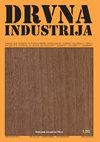木材热处理的化学变化和环境问题
IF 0.8
4区 农林科学
Q4 MATERIALS SCIENCE, PAPER & WOOD
引用次数: 2
摘要
本文综述了木材热处理过程中的化学变化及其对环境的影响。由于其物理和技术特性,木材是最常用的建筑材料之一。各种程序提高其性能,由于其环境可接受性,热处理木材是最常用的一种。热处理引起细胞壁的变化和木材结构的主要成分(纤维素、半纤维素、木质素)和提取物的降解。半纤维素作为最不稳定的成分,首先被分解,其次是纤维素,最后是木质素。降解会导致化学成分的变化和颜色变化的化学反应,这导致了一个技术问题,因为木材加工往往会使颜色尽可能均匀。通过蒸煮和热改性工艺,得到了颜色的均匀性和所需的色调。加工温度是导致所有这些变化的最重要因素。由于其广泛使用,有必要研究这种热处理工艺的生态后果,以及在此过程中释放的有害物质和化合物类型的影响及其毒性。本文章由计算机程序翻译,如有差异,请以英文原文为准。
Chemical Changes and Environmental Issues of Heat Treatment of Wood
The paper gives an overview of chemical changes during heat treatment of wood and their influence on environment. Wood is one of the most used building materials because of its physical and technological properties. Various procedures improve its properties, and due to its environmental acceptability, heat treatment of wood is one of the most commonly used. Heat treatment causes changes in the cell walls and degradation of the main components of the wood structure (cellulose, hemicelluloses, lignin) and extractives. Hemicelluloses, as the most unstable components, are broken down first, followed by cellulose and finally lignin. Degradation results in a change in chemical composition and chemical reactions of colour change causing a technological problem because wood processing tends to make the colour as uniform as possible. The uniformity of colour and the desired colour tone are obtained by the process of steaming and thermal modification. The processing temperature is the most important factor that causes all the changes. Due to its wide use, need has arisen to investigate the ecological consequences of such a heat treatment process, as well as the impact of harmful substances and types of compounds released during the process and their toxicity.
求助全文
通过发布文献求助,成功后即可免费获取论文全文。
去求助
来源期刊

Drvna Industrija
MATERIALS SCIENCE, PAPER & WOOD-
CiteScore
1.80
自引率
9.10%
发文量
32
审稿时长
>12 weeks
期刊介绍:
"Drvna industrija" ("Wood Industry") journal publishes original scientific and review papers, short notes, professional papers, conference papers, reports, professional information, bibliographical and survey articles and general notes relating to the forestry exploitation, biology, chemistry, physics and technology of wood, pulp and paper and wood components, including production, management and marketing aspects in the woodworking industry.
 求助内容:
求助内容: 应助结果提醒方式:
应助结果提醒方式:


